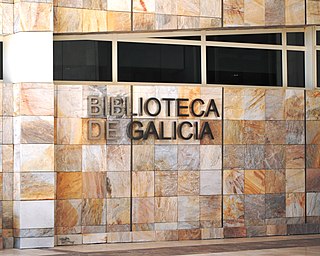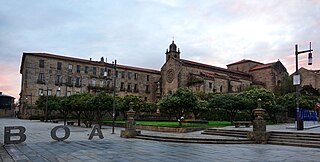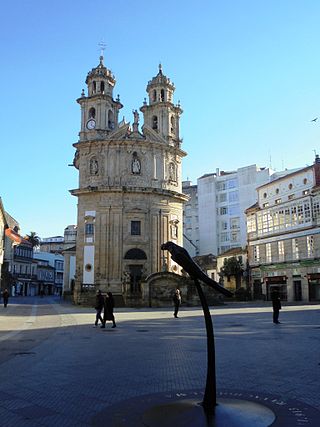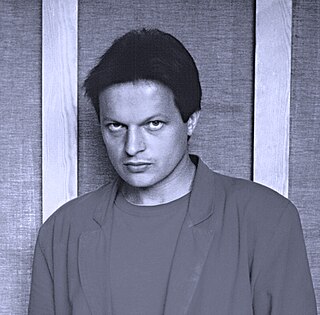
Santiago de Compostela, simply Santiago, or Compostela, in the province of A Coruña, is the capital of the autonomous community of Galicia, in northwestern Spain. The city has its origin in the shrine of Saint James the Great, now the Cathedral of Santiago de Compostela, as the destination of the Way of St. James, a leading Catholic pilgrimage route since the 9th century. In 1985, the city's Old Town was designated a UNESCO World Heritage Site.

Peter David Eisenman is an American architect, writer, and professor. Considered one of the New York Five, Eisenman is known for his high modernist and deconstructive designs, as well as for his authorship of several architectural books. His work has won him several awards, including the Wolf Prize in Arts.

Andrés Jaque is a Spanish architect, writer and curator. In 2016, he was awarded with the 10th Frederick Kiesler Prize for Architecture and the Arts., in 2024 he won the UNESCO Global Award for Sustainable Architecture, and in 2014, the Silver Lion to the Best Project at the 14th Venice Biennale. His work explores architecture as a cosmopolitical practice. In 2003, he founded the Office for Political Innovation, a trandisciplinary agency working in the intersection of design, research and environmental activism.
Carlos Ferrás Sexto is a Galician geographer and academic.
The Edificio Castromil or Castromil Building, previously known as café Quiqui-Bar in Santiago de Compostela, was a building of Eclectic style demolished in 1975 and was located in the Praza de García Prieto.

The 2020 Galician regional election was held on Sunday, 12 July 2020, to elect the 11th Parliament of the autonomous community of Galicia. All 75 seats in the Parliament were up for election. The election was initially scheduled for 5 April 2020 but was postponed as a result of the COVID-19 pandemic. It was held simultaneously with a regional election in the Basque Country.

The Third Feijóo Government was the regional government of Galicia led by President Alberto Núñez Feijóo between 2016 and 2020. It was formed in November 2016 after the September regional election.

Galicia en Común was a left-wing alliance in Galicia formed by Podemos and United Left (EU) as a successor to the En Marea alliance, which after turning into a party broke up from their three constituent parties in early 2019 as a result of political and leadership differences. The alliance has contested the April 2019 and November 2019 Spanish general elections under the En Común–Unidas Podemos label, and it also exists as a sub-group within the Unidas Podemos confederal parliamentary group in the Congress of Deputies. In September 2019, Podemos and EU, together with Renewal–Nationalist Brotherhood, comprised the Grupo Común da Esquerda parliamentary group, and the alliance is scheduled to be renewed ahead of the 2020 Galician regional election.

The Pontevedra Museum is a museum in the Galician city of Pontevedra in Spain. It was founded by the Provincial Deputation of Pontevedra on 30 December 1927 and has six buildings for its exhibitions. It has permanent and temporary exhibition rooms. The museum's collections are multidisciplinary, classified into rooms for painting, sculpture, archaeology, decorative arts, engraving and ethnography.

The former College of the Jesuits is an 18th-century baroque building located in Sarmiento Street in the heart of the old town of Pontevedra, Spain. A secondary educational institution founded by the Jesuits in 1695, the building is known today as the Sarmiento Building and is one of the seats of the Pontevedra Museum.

The Library of Galicia, is a Spain-based public library located in the Galician Cultural City of Santiago de Compostela, the capital of the Galicia Autonomous Region, Spain. It is the largest public library in the Galicia Autonomous Region. The library was designed by American architect Peter Eisenman.

The Gobierno Civil de Pontevedra, currently Subdelegación del Gobierno de Pontevedra, is an official building located in Pontevedra, Galicia (Spain). It has served since its construction as the government delegation office representing the Spanish state in the province of Pontevedra.

Valeriano Martínez was a Spanish politician. A member of the People's Party of Galicia, he served as Minister of Finance of Galicia from 2015 until 2021 and was a member of the Parliament of Galicia from 2016 to 2017.

O Burgo is a neighbourhood in the city of Pontevedra (Spain). It is one of the oldest neighbourhoods in the city and is crossed by the Portuguese Way. On its right-hand side is the A Xunqueira area with important educational and cultural facilities.

The Convent of St. Francis is a Franciscan convent located in the city centre of Pontevedra (Spain), overlooking the Plaza de la Herrería. The Gothic church of San Francis is attached to the convent on the southeast side.

The Plaza de la Peregrina is an 18th-century square located in the city centre of Pontevedra (Spain), on the edge of the historic centre.

The Plaza de España is a 19th century pedestrian square located in the city centre of Pontevedra (Spain), on the edge of the old town and the Alameda de Pontevedra.

Xosé Artiaga Barreira, is a Galician painter, engraver, photographer and multimedia artist, as well as teacher of drawing.

The Ciudad de la Justicia de Pontevedra or the Pontevedra Judicial Complex is an architectural and judicial complex of the city of Pontevedra (Spain), consisting of two large court buildings built in 1998 and 2019 in the A Parda district.

Os Renovadores or Os Novos was a group of artists who wanted to renew the visual Galician arts from the 1920s.




















